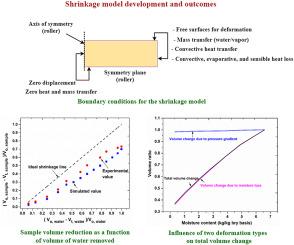A novel mechanistic model for predicting shrinkage kinetics in plant-based foods by integrating solid matrix mobility and viscoelasticity
IF 5.3
2区 农林科学
Q1 ENGINEERING, CHEMICAL
引用次数: 0
Abstract
Deformation during drying is a major physical change influencing drying kinetics and final product quality. Therefore, accurate prediction of shrinkage kinetics is essential for determining the optimal drying conditions for these foods. Shrinkage kinetics is greatly influenced by their structural mobility (rubbery-glassy transition) and viscoelastic properties. The current deformation models lack a comprehensive integration of structural mobility and viscoelasticity concepts, resulting in limitation in attaining insights on physiochemical state variations and viscoelastic stresses developed during drying. In order to overcome this limitation, this study proposes a novel mechanistic shrinkage model that combines solid matrix mobility-based shrinkage velocity and viscoelasticity consideration, incorporating variable mechanical properties to simulate deformation arising from moisture loss and pressure gradient respectively. Comparison between predicted drying kinetics and shrinkage evolution with experimental observation yielded close agreement, achieving low mean absolute error values. As the drying process progressed, a distinct anisotropic shrinkage pattern emerged, which is attributed to varied structural mobility based on temperature and moisture distribution across the food sample. Notably, shrinkage driven by moisture loss significantly outweighed that induced by pressure, exerting a predominant influence on overall volume change. Furthermore, the model demonstrated heightened sensitivity to water transport parameters compared to mechanical factors, which indicates the significance of moisture dynamics in shaping the drying process. Combined consideration of physiochemical changes and viscoelastic concept in the developed deformation model extends new possibility towards optimizing the drying process as well as quality aspect evaluation.

结合固体基质流动性和粘弹性预测植物性食品收缩动力学的新型机理模型
干燥过程中的变形是影响干燥动力学和最终产品质量的主要物理变化。因此,准确预测收缩动力学对于确定这些食品的最佳干燥条件至关重要。收缩动力学在很大程度上受其结构流动性(橡胶-玻璃态转变)和粘弹性能的影响。目前的变形模型缺乏对结构流动性和粘弹性概念的全面整合,从而限制了对干燥过程中产生的理化状态变化和粘弹性应力的深入了解。为了克服这一局限性,本研究提出了一种新的机理收缩模型,该模型结合了基于固体基质流动性的收缩速度和粘弹性考虑,并纳入了可变力学性能,以模拟分别由水分流失和压力梯度引起的变形。将预测的干燥动力学和收缩演变过程与实验观测结果进行比较,结果非常接近,平均绝对误差值较低。随着干燥过程的进行,出现了明显的各向异性收缩模式,这归因于整个食品样品的温度和水分分布导致的不同结构流动性。值得注意的是,水分损失引起的收缩大大超过了压力引起的收缩,对整体体积变化产生了主要影响。此外,与机械因素相比,该模型对水分传输参数的敏感性更高,这表明水分动力学在塑造干燥过程中的重要性。在所开发的变形模型中综合考虑了生理化学变化和粘弹性概念,为优化干燥过程和质量评估提供了新的可能性。
本文章由计算机程序翻译,如有差异,请以英文原文为准。
求助全文
约1分钟内获得全文
求助全文
来源期刊

Journal of Food Engineering
工程技术-工程:化工
CiteScore
11.80
自引率
5.50%
发文量
275
审稿时长
24 days
期刊介绍:
The journal publishes original research and review papers on any subject at the interface between food and engineering, particularly those of relevance to industry, including:
Engineering properties of foods, food physics and physical chemistry; processing, measurement, control, packaging, storage and distribution; engineering aspects of the design and production of novel foods and of food service and catering; design and operation of food processes, plant and equipment; economics of food engineering, including the economics of alternative processes.
Accounts of food engineering achievements are of particular value.
 求助内容:
求助内容: 应助结果提醒方式:
应助结果提醒方式:


